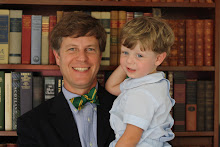October came quickly, and November fast on its heels, notwithstanding that my duties kept me in Charleston for several weeks in November while Elisabeth and Henry settled in Boston. In an act of true chivalry, Elisabeth’s father drove all of our winter clothes that Charleston weather rarely necessitates but which we anticipated needing to brace ourselves against the cold New England winter.
On Friday, 18 November, I drove to Charlotte and stayed overnight. The next morning, as Elisabeth's mother and I headed to the airport, I was as giddy with excitement as a child at Christmas in anticipation of being reunited with my family. The flight was uneventful, and when I finally made my way to the pick-up point, I thought Henry, who had just turned three the previous month, would have to be pried apart from me with a crowbar.
I had notions of exploring a bit of the city with Henry, but Baby Hunter, apparently sensing the family was finally intact, had other plans.
William St. George Hunter, weighing 8 pounds, arrived on November 22, 2012, at 11:27 am at Brigham & Women’s Hospital. What happened from there that day is a bit of a blur. Elisabeth got to see George all too briefly before I accompanied him over for a quick bath and checkup in the critical care nursery before wheeling over to 8 South—the Cardiac ICU at CHB. Before whisking George off, though, the staff at B&W bent the rules a bit by sneaking Henry in to meet his new brother. Having been prepared that we might not get to bring our baby home to Charleston, Henry looked up at me with worlds of expectation in his blue eyes and whispered, “Daddy, can we keep him?”
The next several days were fraught with worry. One moment we seemed on top of the world (“You may have hit the jackpot,” one doctor told us), only a day later to hurry back up to CICU after grabbing a quick breakfast from the ubiquitous Au Bon Pain in the lobby (I think I will mark each of George’s birthdays with a ham and Swiss croissant) to find a medical team hovered over George. “We've observed some subtle signs that eating is putting too much strain on George’s heart, so we’re inserting a feeding tube through his nose.” Nosedive. We quickly discovered that Kipling’s stoic approach served best:
“If you can meet with Triumph and Disaster
And treat those two impostors just the same.”
Nevertheless, George’s general outlook continued to improve.
8 South is quite a close-knit family, thrown together into shared circumstances none of us would have dreamed possible. I found myself in awe of a family who had been there with their six-year-old since May. A single mother next door watched ceaselessly (I won’t say “tirelessly,” because we could read the exhaustion in her eyes) over her son, who had been in and out (mostly in) of 8 South since he’d been born 16 months earlier.
We had much to be thankful for on Thanksgiving Day, two days after George’s arrival. He beat his initial prognosis just by being born, and he seemed to get better each day. A group of volunteers, not just a few of whom were local parents of heart babies, cooked and delivered a full-course Thanksgiving feast for the families of 8 South out-of-towners. My parents, who arrived in time for George’s birth, along with Elisabeth’s parents, spelled each other, and Elisabeth and I, between bites to sit with George.
The weather had been unseasonably warm, but Thanksgiving broke clear and cold. Sensing that Henry needed to get out, and desiring some one-on-one time with him, I bundled us up and took a late afternoon walk with my oldest boy.
CHB, a teaching hospital of Harvard Medical School, sits adjacent to the austere and venerable campus. As we walked across the “Great White Quad,” I explained to Henry, “This is where students go to learn to become doctors.” He mulled a moment and answered, “Daddy, when I grow up I want to be a doctor.”
“Why, Henry?”
“So I can make George’s heart better.”
Although I’ve been knocked cold, I’ve never fainted in my life, but those words sent stars and planets whirring around my head. Here was a three-year-old who had been uprooted from his home and dog and friends and all else familiar and dragged off to a foreign land for to live for what must have seemed forever to him out of a suitcase in a hotel room, and on Thanksgiving his thoughts were for the wellbeing of his brother who had abruptly interjected himself into our heretofore tranquil family life.
We moved from 8 South to “The Floor,” and after thirteen anxious days and nights we were finally allowed to head home … before Christmas, which we had hardly dared hope. Before George, out of the 139 babies who had received successful fetal cardio intervention, only two had been discharged from the hospital without further treatment. George was the third.
Although we had to return for a second balloon catherization the day after Christmas, since then George has done incredibly well, showing steady and incremental improvement. We realize there are no guarantees (are there ever?), but so far George seems to have somewhat astounded his doctors. St. George is famous for slaying the dragon, and our wee St. George has certainly had his dragons to face (though not alone)—and likely yet has more to face. But so far the Great Physician has in his providence seen fit to bless us with a happy, thriving boy, a gift the size of which our gratitude can never measure.
Thanks be to God.




